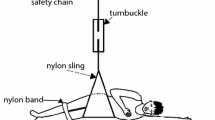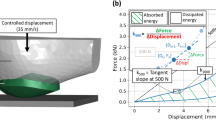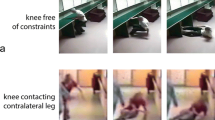Abstract
Fall simulations provide insight into skin-surface impact dynamics but have focused on vertical force magnitude. Loading direction and location (relative to the femur) likely influence stress generation. The current study characterized peak impact vector magnitude, orientation, and center of pressure over the femur during falls, and the influence of biological sex and trochanteric soft tissue thickness (TSTT). Forty young adults completed fall simulations including a vertical pelvis release, as well as kneeling and squat releases, which incorporate lateral/rotational motion. Force magnitude and direction varied substantially across fall simulations. Kneeling and squat releases elicited 57.4 and 38.8% greater force than pelvis release respectively, with differences accentuated in males. With respect to the femoral shaft, kneeling release had the most medially and squat release the most distally directed loading vectors. Across all fall simulations, sex and TSTT influenced force magnitude and center of pressure. Force was 28.0% lower in females and was applied more distally than in males. Low-TSTT participants had 16.8% lower force, applied closer to the greater trochanter than high-TSTT participants. Observed differences in skin-surface impact dynamics likely interact with underlying femur morphology to influence stress generation. These data should serve as inputs to tissue-level computational models assessing fracture risk.






Similar content being viewed by others
Abbreviations
- BMI:
-
Body mass index
- CoP:
-
Center of pressure
- FoR:
-
Factor of risk
- GT:
-
Greater trochanter
- TSTT:
-
Trochanteric soft tissue thickness
References
Chevalley, T., E. Guilley, F. R. Herrmann, P. Hoffmeyer, C. H. Rapin, and R. Rizzoli. Incidence of hip fracture over a 10-year period (1991–2000): reversal of a secular trend. Bone. 40:1284–1289, 2007.
Choi, W. J., J. A. Hoffer, and S. N. Robinovitch. Effect of hip protectors, falling angle and body mass index on pressure distribution over the hip during simulated falls. Clin. Biomech. 25:63–69, 2010.
Choi, W. J., J. M. Wakeling, and S. N. Robinovitch. Kinematic analysis of video-captured falls experienced by older adults in long-term care. J. Biomech. 48:911–920, 2015.
Choi, W. J., and S. N. Robinovitch. Effect of pelvis impact angle on stresses at the femoral neck during falls. J. Biomech. 74:41–49, 2018.
Cibulka, M. Determination and significance of femoral neck anteversion. Phys. Therapy. 84:550–558, 2004.
de Bakker, P. M., S. L. Manske, V. Ebacher, T. R. Oxland, P. A. Cripton, and P. Guy. During sideways falls proximal femur fractures initiate in the superolateral cortex: evidence from high-speed video of simulated fractures. J. Biomech. 42:1917–1925, 2009.
Etheridge, B. S., D. P. Beason, R. R. Lopez, J. E. Alonso, G. McGwin, and A. W. Eberhardt. Effects of trochanteric soft tissues and bone density on fracture of the female pelvis in experimental side impacts. Ann. Biomed. Eng. 33:248–254, 2005.
Falcinelli, C., E. Schileo, L. Balistreri, F. Baruffaldi, B. Bordini, M. Viceconti, U. Albisinni, F. Ceccarelli, L. Milandri, A. Toni, and F. Taddei. Multiple loading conditions analysis can improve the association between finite element bone strength estimates and proximal femur fractures: a preliminary study in elderly women. Bone. 67:71–80, 2014.
Fleps, I., P. Guy, S. J. Ferguson, P. A. Cripton, and B. Helgason. Explicit finite element models accurately predict subject-specific and velocity-dependent kinetics of sideways fall impact. J. Bone Miner. Res. 34:1837–1850, 2019.
Fleps, I., A. Fung, P. Guy, S. J. Ferguson, B. Helgason, and P. A. Cripton. Subject-specific ex vivo simulations for hip fracture risk assessment in sideways falls. Bone. 125:36–45, 2019.
Hayes, W. C., E. R. Myers, J. N. Morris, T. N. Gerhart, H. S. Yett, and L. A. Lipsitz. Impact near the hip dominates fracture risk in elderly nursing home residents who fall. Calcified Tissue Int. 52:192–198, 1993.
Kannegaard, P. N., S. van der Mark, P. Eiken, and B. Abrahamsen. Excess mortality in men compared to women following a hip fracture. National analysis of comedications, comorbidity and survival. Age Ageing. 39:203–209, 2010.
Keyak, J. H., H. B. Skinner, and J. A. Fleming. Effect of force direction on femoral fracture load for two types of loading conditions. J. Orthop. Res. 19:539–544, 2001.
Lafleur, B. Factors influencing measures of trochanteric soft tissue thickness. UWSpace. 2016.
Levine, I.C. The effects of body composition and body configuration on impact dynamics during lateral falls: insights from in-vivo, in-vitro, and in- silico approaches. UWSpace. 2017.
Levine, I. C., L. E. Minty, and A. C. Laing. Factors that influence soft tissue thickness over the greater trochanter: application to understanding hip fractures. Clin. Anat. 28:253–261, 2015.
Levine, I. C., S. Bhan, and A. C. Laing. The effects of body mass index and sex on impact force and effective pelvic stiffness during simulated lateral falls. Clin. Biomech. 28:1026–1033, 2013.
Ley, C. J., B. Lees, and J. C. Stevenson. Sex- and menopause-associated changes in body-fat distribution. Am. J. Clin. Nutr. 55:950–954, 1992.
Lim, K. T., and W. J. Choi. Soft tissue stiffness over the hip increases with age and its implication in hip fracture risk in older adults. J. Biomech. 93:28–33, 2019.
Maitland, L. A., E. R. Myers, J. A. Hipp, W. C. Hayes, and S. L. Greenspan. Read my hips: measuring trochanteric soft tissue thickness. Calcified Tissue Int. 52:85–89, 1993.
Martel, D. R., M. Lysy, and A. C. Laing. Predicting population level hip fracture risk: a novel hierarchical model incorporating probabilistic approaches and factor of risk principles. Comput. Methods Biomech. Biomed. Eng. 23:1201–1214, 2020.
Mayhew, P. M., C. D. Thomas, J. G. Clement, N. Loveridge, T. J. Beck, W. Bonfield, C. J. Burgoyne, and J. Reeve. Relation between age, femoral neck cortical stability, and hip fracture risk. Lancet. 366:129–135, 2005.
Nasiri, M., and Y. Luo. Study of sex differences in the association between hip fracture risk and body parameters by DXA-based biomechanical modeling. Bone. 90:90–98, 2016.
Palanca, M., E. Perilli, and S. Martelli. Body anthropometry and bone strength conjointly determine the risk of hip fracture in a sideways fall. Ann. Biomed. Eng. 49:1380–1390, 2021.
Pinilla, T. P., K. C. Boardman, M. L. Bouxsein, E. R. Myers, and W. C. Hayes. Impact direction from a fall influences the failure load of the proximal femur as much as age-related bone loss. Calcified Tissue Int. 58:231–235, 1996.
Pretty, S. P., D. R. Martel, and A. C. Laing. The influence of body mass index, sex, & muscle activation on pressure distribution during lateral falls on the hip. Ann. Biomed. Eng. 45:2775–2783, 2017.
Pulkkinen, P., F. Eckstein, E. M. Lochmüller, V. Kuhn, and T. Jämsä. Association of geometric factors and failure load level with the distribution of cervical vs trochanteric hip fractures. J. Bone Miner. Res. 21:895–901, 2006.
Travison, T. G., A. B. Araujo, G. R. Esche, T. J. Beck, and J. B. Mckinlay. Lean mass and not fat mass is associated with male proximal femur strength. J. Bone Miner. Res. 23:189–198, 2008.
van der Zijden, A. M., B. E. Groen, E. Tanck, B. Nienhuis, N. Verdonschot, and V. Weerdesteyn. Can martial arts techniques reduce fall severity? An in vivo study of femoral loading configurations in sideways falls. J. Biomech. 45:1650–1655, 2012.
van der Zijden, A. M., D. Janssen, N. Verdonschot, B. E. Groen, B. Nienhuis, V. Weerdesteyn, and E. Tanck. Incorporating in vivo fall assessments in the simulation of femoral fractures with finite element models. Med. Eng. Phys. 37:593–598, 2015.
Yang, Y., K. S. van Schooten, J. Sims-Gould, H. A. McKay, F. Feldman, and S. N. Robinovitch. Sex differences in the circumstances leading to falls: Evidence from real-life falls captured on video in long-term care. J. Am. Med. Direct. Assoc. 19:110–116, 2018.
Yang, Y., V. Komisar, N. Shishov, B. Lo, A. M. Korall, F. Feldman, and S. N. Robinovitch. The effect of fall biomechanics on risk for hip fracture in older adults: a cohort study of video-captured falls in long-term care. J. Bone Miner. Res. 35:1914–1922, 2020.
Acknowledgments
This research was funded in part by grants from the Natural Sciences and Engineering Research Council of Canada (RGPIN-2015-03636 and 416587), the Canadian Foundation for Innovation (Grant #25351), and the Ontario Ministry of Research and Innovation (Grant #25351 and ER14-10-236). SPP is a recipient of a Vanier Canada Graduate Scholarship from the Natural Sciences and Engineering Research Council of Canada.
Author information
Authors and Affiliations
Corresponding author
Additional information
Associate Editor Stefan M. Duma oversaw the review of this article.
Publisher's Note
Springer Nature remains neutral with regard to jurisdictional claims in published maps and institutional affiliations.
Rights and permissions
About this article
Cite this article
Pretty, S.P., Levine, I.C. & Laing, A.C. Anatomically Aligned Loading During Falls: Influence of Fall Protocol, Sex and Trochanteric Soft Tissue Thickness. Ann Biomed Eng 49, 3267–3279 (2021). https://doi.org/10.1007/s10439-021-02852-6
Received:
Accepted:
Published:
Issue Date:
DOI: https://doi.org/10.1007/s10439-021-02852-6




